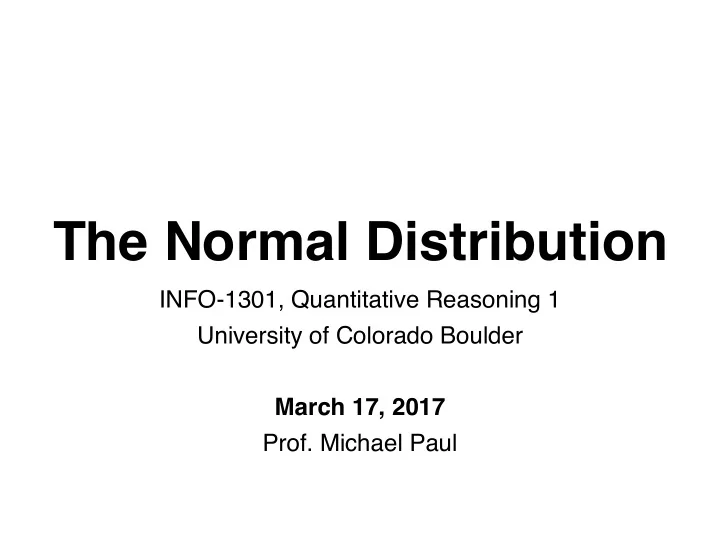

The Normal Distribution INFO-1301, Quantitative Reasoning 1 University of Colorado Boulder March 17, 2017 Prof. Michael Paul
Normal Distribution
Normal Distribution
Normal Distribution • The most common curve in all of statistics and in all of the applications of statistics to science • Unimodal, symmetric, bell curve • Few data sets are perfectly normal in real life, but many are almost normal and many applications benefit from treating the distribution as normal • First mathematical analysis of the normal distribution by Carl Frederic Gauss (1809) Also called the Gaussian distribution
Normal Distribution • The normal distribution is defined by the mean (mu, written as μ ) and the standard deviation (sigma, written as σ ) • Written as N( μ , σ ) • Or sometimes N( μ , σ 2 ) to show variance instead of standard deviation • μ and σ are called parameters . • http://students.brown.edu/seeing- theory/distributions/index.html#second • N(0, 1) is called the standard normal distribution
Probability Density • What does the normal distribution tell us? • The sample space is continuous: our concept of probability doesn’t quite apply • Instead: probability density
Probability Density • What does probability density tell us? • Probability of ranges : • “P(-1 ≤ X ≤ 1) = 0.68” • Relative probability: • “It is twice as likely that X will be 0 than X will be 1.5”
Normal Approximation Real data often naturally forms a normal curve • Not an exact match, but a good approximation
Normal Approximation Using the normal distribution as an approximation to your data can help answer questions like: • Probability of ranges : • “P(-1 ≤ X ≤ 1) = 0.68” • Relative probability: • “It is twice as likely that X will be 0 than X will be 1.5”
Normal Approximation If your data is not reliable, the normal distribution will be a “smoother” curve, potentially more accurate than your actual data.
Normal Approximation Examples of normally distributed data: • Speeds of different cars at a spot on a highway • Physical attributes (e.g., height of people) • Measurement error (e.g., radar speed guns) • Test scores
Normal Approximation • When the normal distribution is a bad approximation: • Bimodal or multimodal distributions • Skewed (left or right) distributions
What can we do with this? If the normal distribution is a good approximation, then we can use the math of the probability density to answer questions about the data: • Probability of ranges • Relative probability
What can we do with this? Common use case: measurement error • We can quantify the probability that our error is acceptably small
Recommend
More recommend